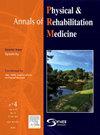强化跨学科专业康复还是常规物理治疗多发性硬化症?一项具有经济评价的随机对照试验。
IF 4.6
3区 医学
Q1 REHABILITATION
Annals of Physical and Rehabilitation Medicine
Pub Date : 2025-01-15
DOI:10.1016/j.rehab.2024.101898
引用次数: 0
摘要
背景:门诊专科(IROSU)跨学科康复的益处尚未确定。目的:比较IROSU和社区物理治疗对多发性硬化症(pwMS)患者损伤、功能和生活质量(QoL)的影响,并确定其医学-经济影响。方法:实用、多中心、平行、随机(集中计算机随机化)对照试验。分析148例pwMS (IROSU组73例,社区组75例)。IROSU包括平衡、伸展、行走、阻力和耐力训练。6分钟步行测试(6MWT)是主要结果。次要结果是超过10米的速度、定时上、下和楼梯测试、平衡(Berg平衡量表、姿势学)、膝关节伸屈肌力(等速测力仪)、峰值功率输出(循环测试)、疲劳(疲劳严重程度量表、修正疲劳影响量表)、生活质量(EuroQol EQ5D3 L、SEP59)、焦虑和抑郁(医院焦虑和抑郁量表)和多发性硬化症影响量表。在训练前、训练后4周以及训练开始后3个月和6个月,由盲法分组分配的治疗师进行评估。采用线性混合效应模型(意向-治疗分析)。分析了成本效益比和成本效用比。结果:从基线到M1 (423.8 (126.7) m至476.0 (119)m IROSU, 404.4 (99.3) m至440.5 (112.1)m community, P < 0.001), M3 (P < 0.001)和M6 (P = 0.001),两组的6MWT增加相似。IROSU组膝关节伸肌力量、力量输出和qol -身体健康改善明显(P < 0.05,效应量0.25 ~ 0.61)。在6个月的随访中,许多改善得以保持。质量调整寿命年和成本效用比的增加有利于IROSU。结论:两组的步行距离都有类似的改善,但效果不明显。IROSU后的次要结果和质量调整生命年的较大改善,维持在6个月的随访,表明pwMS应该每年都参加这个项目。试验注册临床试验:NCT01871818。本文章由计算机程序翻译,如有差异,请以英文原文为准。
Intensive interdisciplinary specialized rehabilitation or regular physiotherapy for multiple sclerosis? A randomised controlled trial with economic evaluation
Background
The benefits of Interdisciplinary Rehabilitation in an Outpatient Specialised Unit (IROSU) have not been determined.
Objectives
To compare the effects of IROSU and physiotherapy in the community on impairment, function and Quality Of Life (QoL) in people with Multiple Sclerosis (pwMS) and to determine the medico-economic impact.
Methods
Pragmatic, multicentre, parallel, randomized (centralised computer-generated randomisation) controlled trial. 148 pwMS were analysed (73 in the IROSU group, 75 in the community group). IROSU included balance, stretching, walking, resistance and endurance training. The 6-Minute Walk Test (6MWT) was the primary outcome. Secondary outcomes were speed over 10 m, Timed Up and Go and Stair test, balance (Berg Balance Scale, posturology), knee extensor and flexor strength (isokinetic dynamometer), peak power output (cycling test), fatigue (Fatigue Severity Scale, Modified Fatigue Impact Scale), QoL (EuroQol EQ5D3 L, SEP59), anxiety and depression (Hospital Anxiety and Depression scale) and Multiple Sclerosis Impact Scale. Evaluations were performed before, after 4 weeks of training and 3 and 6 months after the start by therapists blinded to group allocation. Linear mixed effect models were used (intention-to-treat analysis). Cost-effectiveness and cost-utility ratios were analysed.
Results
6MWT increased similarly in both groups from baseline to M1 (423.8 (126.7) m to 476.0 (119) m IROSU, 404.4 (99.3) m to 440.5 (112.1) m community, P < 0.001), to M3 (P < 0.001) and to M6 (P = 0.001). Knee extensor strength, power output and QoL-physical health improved significantly more in IROSU group (P < 0.05, effect size 0.25–0.61). Many improvements were maintained at the 6-month follow-up. Gain in quality adjusted life years and cost-utility ratios were in favour of IROSU.
Conclusions
Walking distance improved similarly in both groups but this was underpowered. The larger improvements in secondary outcomes and quality-adjusted life years after IROSU, maintained at the 6-month follow-up, suggest pwMS should have access to this program each year.
Trial registration Clinical Trials
NCT01871818.
求助全文
通过发布文献求助,成功后即可免费获取论文全文。
去求助
来源期刊

Annals of Physical and Rehabilitation Medicine
Medicine-Rehabilitation
CiteScore
7.80
自引率
4.30%
发文量
136
审稿时长
34 days
期刊介绍:
Annals of Physical and Rehabilitation Medicine covers all areas of Rehabilitation and Physical Medicine; such as: methods of evaluation of motor, sensory, cognitive and visceral impairments; acute and chronic musculoskeletal disorders and pain; disabilities in adult and children ; processes of rehabilitation in orthopaedic, rhumatological, neurological, cardiovascular, pulmonary and urological diseases.
 求助内容:
求助内容: 应助结果提醒方式:
应助结果提醒方式:


